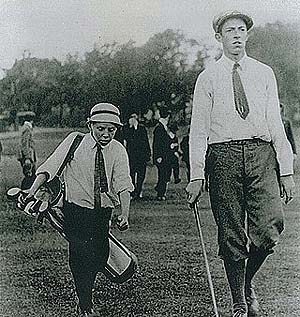Ouimet's victory ushers in new golf era in U.S.

Shown here in the legendary photo with caddy Eddie Lowery
By Doug Stark, USGA
FAR HILLS, N.J. (Feb. 5, 2008)-- On Sept. 20, 1913, golf in America changed forever. The change wasn’t subtle or difficult to detect to the naked eye. It wasn’t something that would need to be re-interpreted by journalists and writers 20 years in the future. Academics would not need to discuss the merits of what happened or place it within some theoretical framework. The change was immediate and radical. It was understood by everyone. The first turning point for golf in America had arrived.
On that early New England fall day, 20-year-old amateur and former caddie Francis Ouimet defeated legendary British professionals Harry Vardon and Ted Ray in a playoff to win the U.S. Open.
Ouimet’s victory, his dethroning of the great British golfers of the day, paralleled America’s relationship with Great Britain. In 1913, the balance of power in the world was shifting. Great Britain, long a powerful empire, found its dominance challenged by an upstart, the United States. America was growing, asserting itself on the world stage as expansionist policies gave it a presence in Asia and Latin America. America was poised to take that next step.
Golf in 1913 was still Scottish in its appearance, manner and sensibility. There was little that was uniquely American about the game. Even though the United States Golf Association had been established in 1894 to conduct championships and write the Rules, the game was still viewed as a foreign import. Even the few American stars of the day had little connection with the sporting public. Golf did not resonate with the masses.
Ouimet single-handedly changed all that. He did so in dramatic fashion.
When Ouimet took to the course for the first round at The Country Club in Brookline, Mass., all eyes were focused on Ray and Vardon. Prior to the championship, the two golf stars had traveled across the country, playing matches that were contested before record or near-record galleries. The Americans they played had improved considerably since Vardon’s last tour of the United States in 1900, but both were heavily favored at the U.S. Open. As play started, it was generally assumed that one of them would win.
Ouimet hung around, slowly working himself into contention as the championship progressed. He tied Vardon and Ray at the end of four rounds, aided by a crucial birdie on the 71st hole. Expected to wilt under the pressure of the playoff the following day, Ouimet played his best golf of the championship in a driving rain, shooting 72 against Vardon’s 77 and Ray’s 78. His startling victory placed golf on the front page of many American newspapers for the first time and inspired a new generation to take up the game.
In a country celebrating the rags to riches stories of Horatio Alger, where immigrants were coming ashore daily seeking a new life, Ouimet’s triumph resonated with an entire generation. It was the century’s first great golf moment. In a country still searching for a sports identity, Ouimet’s victory made golf American.
His story and its themes would become part of America’s national identity. David defeating Goliath. A young upstart, not given much of a chance, overcomes adversity to become a champion. An immigrant works his way to the top while staying humble and never forgetting his roots.
In Ouimet, America found its first golf hero and the dawn of America’s century of golf had begun.